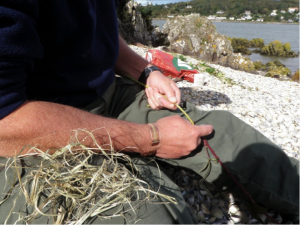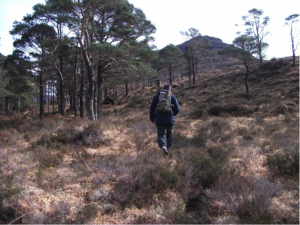I am an experimental archaeologist, as such I use primitive technologies and ancient skills to understand how our ancestors used to live. Some of my projects have included; stone bead making in Romania, tree bast experiments in Denmark, and Neanderthal birch bark tar production. In short, a range of exciting and fascinating projects. A major recent project for me has been to work on the west coast of Scotland trying to figure out how Mesolithic (11,500–6000 cal BP) hunter-gatherers were living. Archaeologists have evidence for the importance of fish and shellfish to their diet, but virtually nothing is known as to how these were caught or collected.
My research attempted to change this by using a combination of bushcraft/primitive skills and experimental archaeology. Initially, my work focussed on the prehistoric environments of Scottish west coast Mesolithic coastal sites. I then looked at a range of archaeological/traditional fishing gear and food collection strategies to see what might have been used in the Mesolithic. These perspectives, together with the prehistoric environmental data, guided my construction and use of fishing gear, working with the resources and technologies available to Mesolithic hunter-gatherers. Using my bushcraft/primitive skills I was able to make fishing lines from a range of materials; this included nettles as well as the bark from various trees. I also made basketry fish and crab pots that varied in size and shape depending on the type of natural vegetation that I had used. It was vital that I only used natural un-managed vegetation typical of the habitats of the Scottish Mesolithic and that I only used tools of stone, bone or shell. Only by restricting myself to the resources and tool kit of a Mesolithic hunter-gatherer could I go through similar thought processes and experiences.

I ended up spending much of my time grubbing around on remote Scottish islands, testing whatever I could find to see if I could make fishing lines, hooks or basket traps. This involved travelling to some of the most beautiful parts of Scotland and sitting on the coast fishing with my hand made gear.
I made and tested a wide range of fishing gear and travelled thousands of miles over 4 years and started to feel like a Mesolithic hunter-gatherer; lugging fishing gear to remote sites, planning to maximise the use of tides, experiencing lousy weather. These experiences provided me with an insight into the world of the Mesolithic coastal hunter-gatherer, revealing the extent of organisation and knowledge that they must have had in order to fully utilise their environment. The planning needed to maximise returns, whether foraging, hunting or collecting resources. The knowledge required of the environment; the places to find the best materials for a particular task, knowledge of seasons and the seasonal movement of species, when and where to be at a particular place at a particular time. This is how experimental archaeology can fill in some of the gaps in the archaeologicalrecord, the human facets that are missing.

It is of course very difficult to understand the mind-set of someone who lived 8000 years ago, but by using those ancient hunter-gatherer skills together with experimental archaeology, we can move some way toward them.
Dr Peter Groom is Course Manager of the Environmental Archaeology and Primitive Skills Programme at Reaseheath College, Nantwich, Cheshire, and a Director of the Mesolithic Resource Group mesolithic.org.uk.
